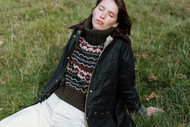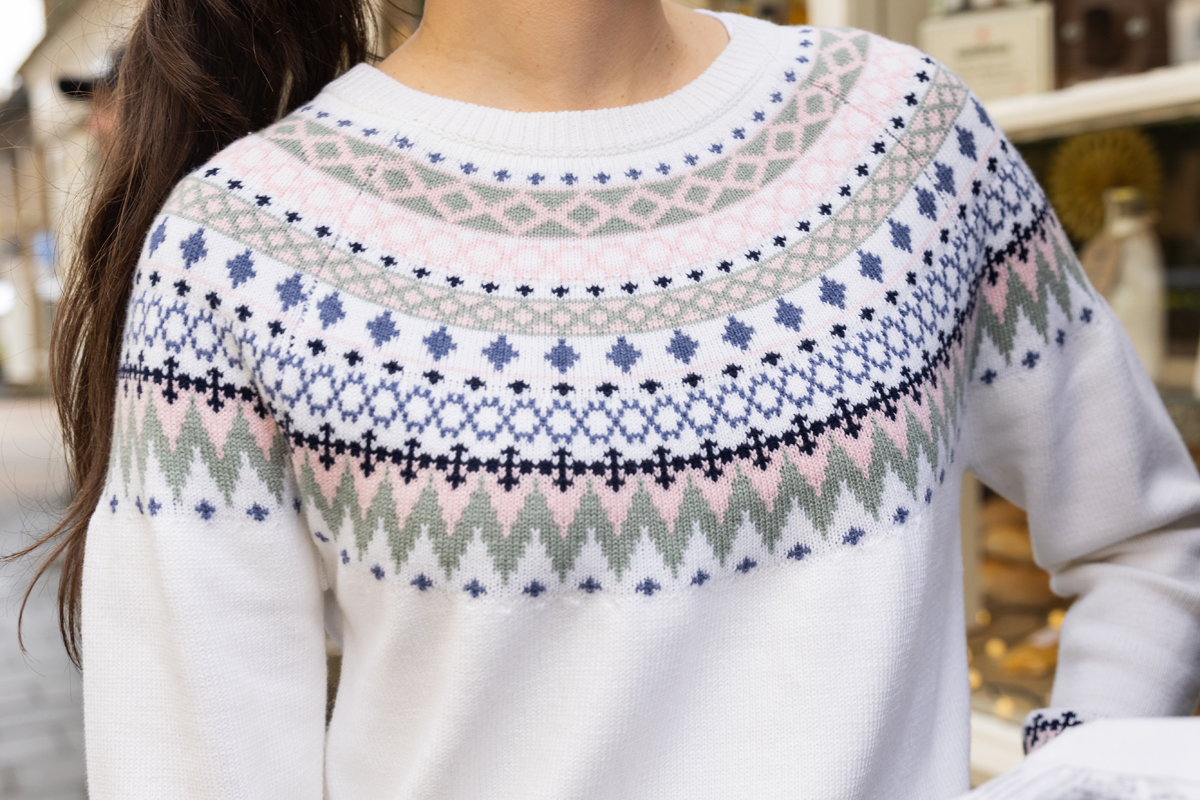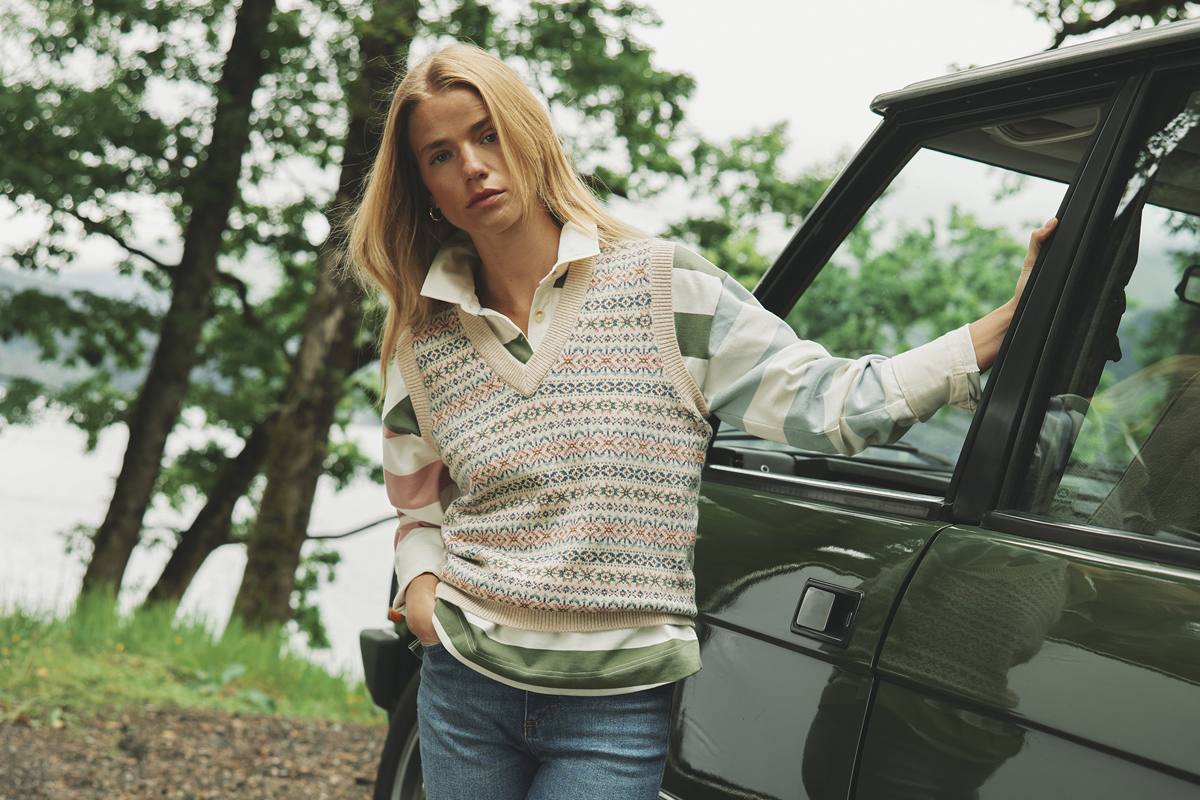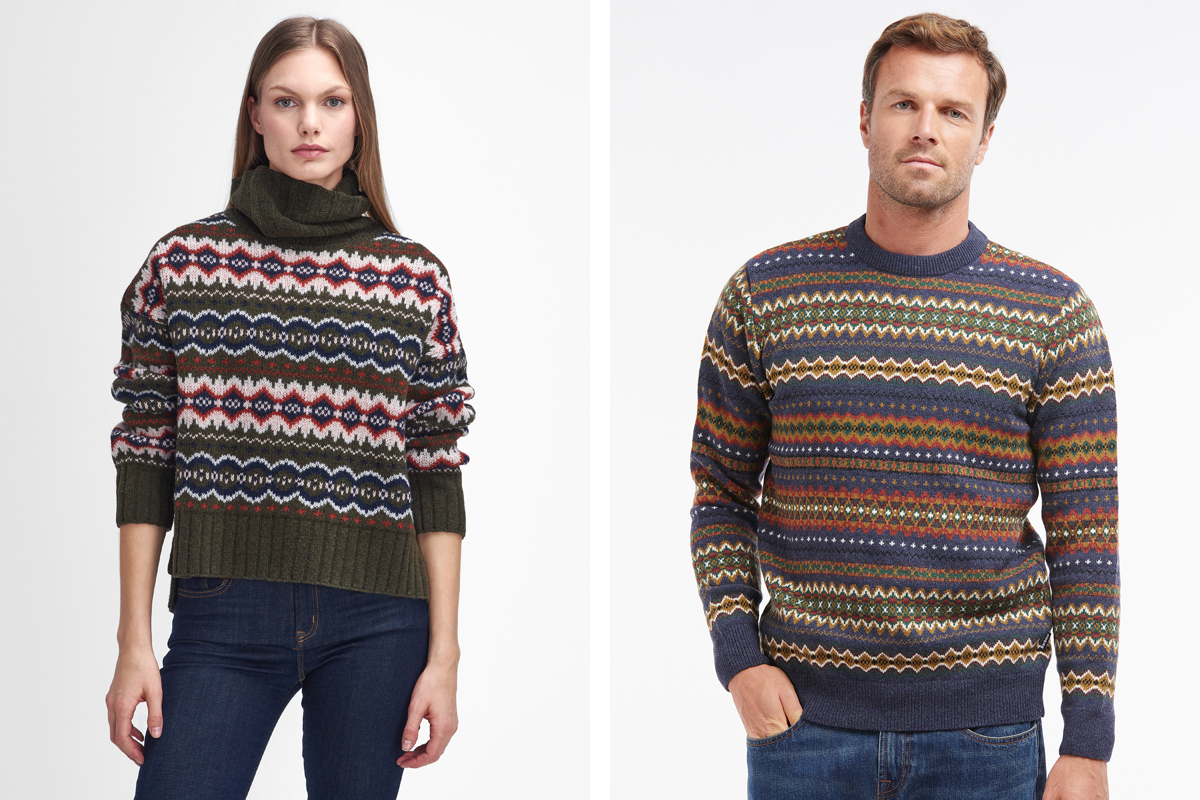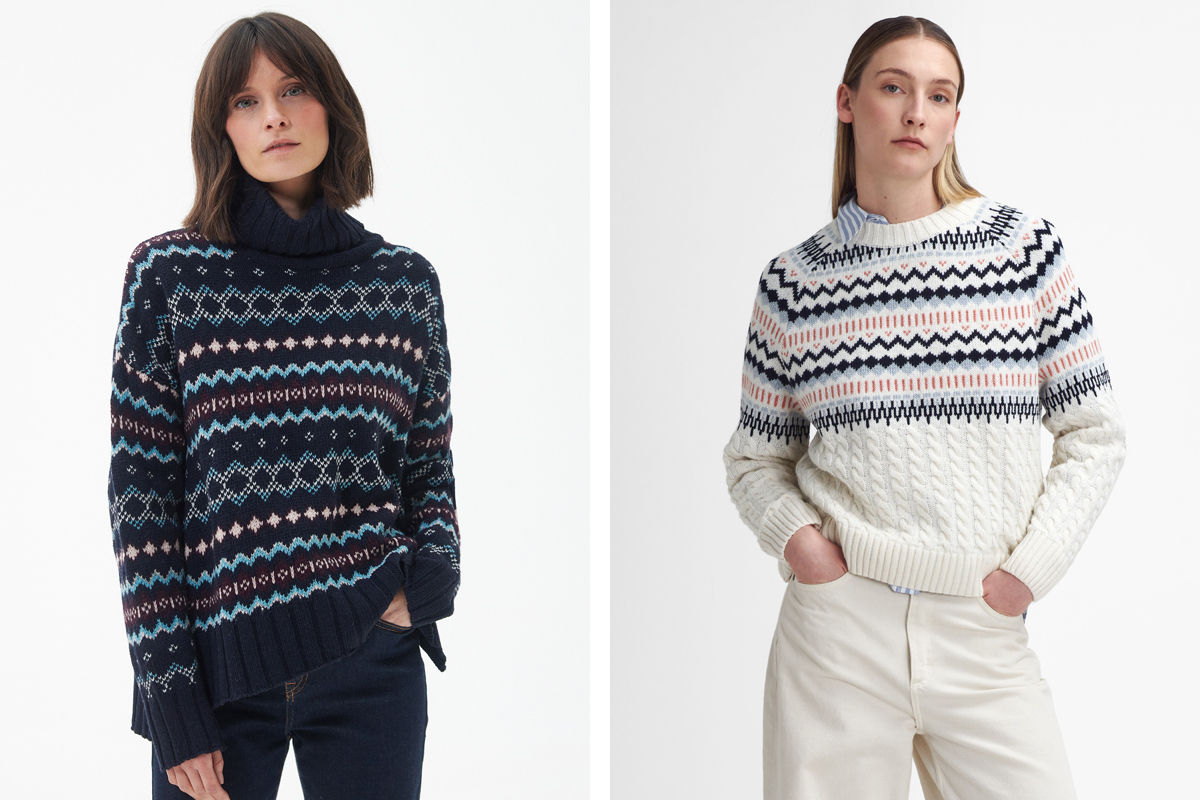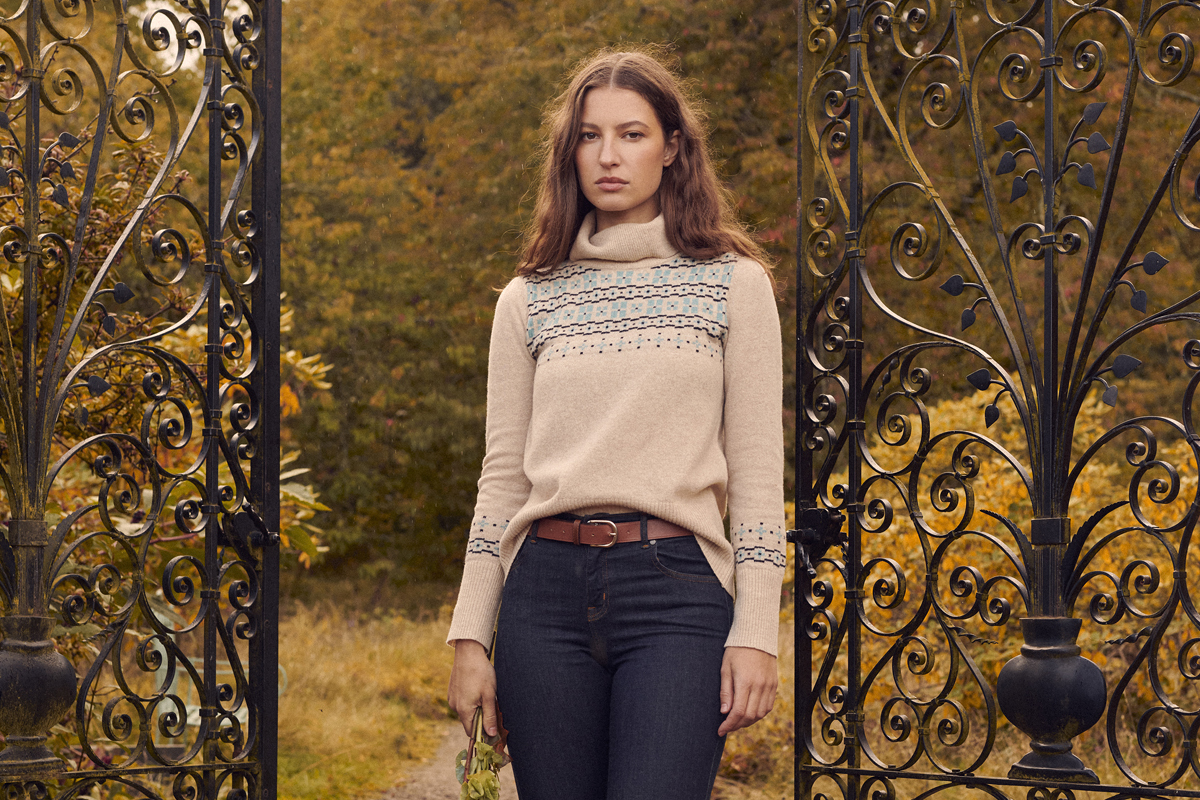The Fair Isle jumper, with its distinctive patterns and vibrant colours, is a style of knitwear with a rich history that has become famous worldwide. Originating from the tiny Scottish island of Fair Isle, situated between the Shetland Islands and the Orkney Islands, the Fairisle jumper has become an iconic symbol of British knitwear.
Origins of Fair Isle Jumpers
Fair Isle knitting is a traditional technique characterised by intricate patterns made from multiple colours of wool. Its origins are rooted in the isolated communities of Fair Isle, where knitting became a vital craft. Located in the North Sea, Fair Isle has a history of self-sufficiency, with its inhabitants depending on fishing, farming, craft and trade to survive in harsh conditions.
The vibrant geometric patterns of Fair Isle jumpers are thought to have been influenced by trade routes that passed through the island. Some theories suggest that sailors or traders from Scandinavia or the Baltic regions introduced knitting techniques and patterns that later evolved into the distinctive Fair Isle style. By the early 19th century, local knitters had refined these influences into their own unique motifs, incorporating small geometric shapes, stars, and crosses. Using wool from the native Shetland sheep, they crafted items such as fishermen's hats and jumpers designed to provide warmth and protection during long days at sea.
The Rise of the Fair Isle Jumper
The popularity of the Fair Isle jumper began to grow in the late 19th century with the earliest advertisement for Fairisle jumpers appearing in The Shetland Advertiser in 1862. A key moment in the Fair Isle jumper’s rise to prominence came in 1921, when the future King Edward VIII (then the Prince of Wales) was photographed wearing a Fairisle jumper while playing golf. This image captivated the British public, transforming the humble Fair Isle jumper into a fashionable statement. The Prince's endorsement made it highly desirable, and suddenly, what was once a humble craft from a remote island became a symbol of aristocratic chic.
This new found popularity spread throughout Britain and Europe, with knitwear designers and fashion houses starting to incorporate Fair Isle patterns into their collections. The rich colour palette of Fairisle jumpers, which traditionally used natural dyes from local plants and lichens, was also modernised with brighter, chemical dyes that became available in the 20th century, further broadening their appeal.
Craftsmanship and Tradition of Fair Isle Jumpers
Despite the fashion industry's embrace of the Fair Isle jumper, the craft itself has remained rooted in traditional methods passed down through generations. Authentic Fair Isle knitting uses an "in the round" technique, crafted by hand with double-pointed needles and aided by a padded knitting belt—a method still practiced on the island today. Traditional Fair Isle jumper designs typically feature up to four colours, with no more than two colours used in each row. The colour transitions are skilfully woven into the back of the fabric, creating a smooth, almost seamless finish. These intricate patterns are often arranged in repeating bands across the yoke of the jumper, maintaining the timeless charm of this artisanal craft.
Fair Isle jumpers are not only functional, providing essential warmth in cold weather, but they are also a testament to the island's cultural heritage. Each design is unique, as no two knitters produce the exact same piece, with many designs passed down through generations and memorised rather than relying on written patterns. This individuality reflects both the craftsmanship and traditions of the island, making each Fairisle jumper a blend of artistry and history.
Fair Isle Jumper in Modern Fashion
Throughout the 20th century, Fair Isle jumpers have experienced periodic resurgences in popularity. In the 1970s and 1980s, they became emblematic of British heritage style, and their retro appeal has kept Fair Isle knitting a recurring feature on fashion runways, especially during the autumn and winter seasons.
In recent years, there has been a renewed interest in heritage crafts and vintage styles, drawing fresh attention to Fairisle jumpers and knitting. Modern examples include the Barbour Mens Case Fairisle Crew Neck , the Barbour Womens Helen Knitted Jumper and the Joules Islay Fairisle V Neck Vest Top, all featuring retro-inspired Fair Isle patterns that capture the timeless charm of this knitting tradition. Fair Isle designs are not just limited to jumpers; their geometric designs are also popular in winter accessories, such as the Barbour Womens Claudia Fairisle Beanie and the Dubarry Kilcormac Knitted Hat and cosy socks such as the House Of Cheviot Womens Fairisle Tall Boot Socks or the Barbour Mens Boyd Socks.
Although "Fair Isle" has become a broader term for multi-coloured knitwear, authentic Fair Isle jumpers are still produced in small quantities on the island itself, using patterns passed down through generations. While machine-made versions of Fair Isle jumpers are widely available in shops and online, a dedicated community of craftspeople, particularly in Fair Isle and Shetland, continues to create sought-after, hand-knitted pieces that preserve the integrity of this craft.
Conclusion
The Fair Isle jumper is more than just a fashionable piece of knitwear; it represents centuries of craft, trade, culture, and community. From its humble origins on a small Scottish island to becoming a fashion staple, the Fair Isle jumper continues to charm with its intricate designs and timeless appeal. As fashion becomes more focused on sustainability and craftsmanship, this iconic knitwear’s legacy remains as vibrant as the patterns that make it so special.

Posted by Abi
Abi is a web content specialist and brand manager at Philip Morris & Son, where she plays a key role in shaping the success of a diverse range of core brands, including Ariat, Alan Paine, Brabantia, Blundstone, Dubarry, and Lazy Jacks. With over 10 years of experience in the clothing retail sector, Abi joined the company in 2022, and her creativity and keen attention to detail are instrumental in enhancing product pages and optimising SEO strategies to drive brand visibility and growth.
Growing up surrounded by the Herefordshire countryside, Abi's love for the outdoors informs her understanding of the products that resonate with our customers. Her enjoyment of outdoor activities including camping and hiking gives her first-hand knowledge of how the right gear can enhance outdoor experiences. This personal insight enables her to expertly curate products that meet the needs of fellow outdoor enthusiasts. Outside of work, Abi also enjoys live music, is a keen cook and yoga enthusiast, and has recently taken up running (again!).

